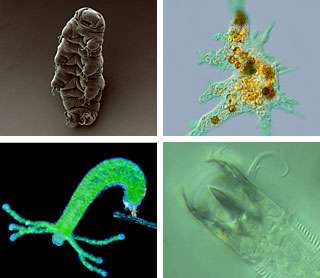Network to study environmental microbes

They're tiny, everywhere and vital to the environment, but biologists have largely overlooked the worms, fungi and single-celled animals found in every environment on Earth. A new research coordination network based at the University of California, Davis and the University of New Hampshire aims to correct that, applying new genome sequencing technology to study these organisms.
The Research Coordination Network on eukaryotic biodiversity is funded by a five-year grant of $500,000 from the National Science Foundation.
"I call them the 'dark matter' of biology," said Holly Bik, a postdoctoral researcher at UC Davis and co-principal investigator on the project with Professor W. Kelley Thomas at the University of New Hampshire. "They are in every single environment, but no one looks at them."
The microscopic eukaryotes fall between two other groups that are much better studied: Animals, plants and fungi visible to the naked eye, and the prokaryotes (mostly bacteria). They include microscopic worms (nematodes), some fungi and single-celled animals (protozoa).
These organisms play a vital role in ecosystems, Bik said, for example by breaking down organic matter and turning over soil nutrients.
Traditionally, they have been studied based on their appearance under the microscope. Now, new high-throughput DNA sequencing technology makes it possible to identify and classify these organisms much more quickly and comprehensively.
Just as medical researchers have begun to realize that the community of microbes on and inside our bodies influences health, biologists have also begun to pay attention to how a flourishing community of microorganisms affects the environment, Bik said.
The goal of the network is to bring together researchers from different fields: taxonomists expert in identifying organisms; ecologists who study these ecosystems; genome scientists and computational biologists who can figure out how to analyze sequence data from these relatively complex animals.
The team aims to organize an annual "catalysis" meeting to bring researchers together, Bik said. They will also sponsor symposia at other scientific meetings.
Working with other colleges including historically black colleges and universities, the network will develop undergraduate training programs on taxonomy and genomics, based at UNH.
"If we want the field to move forward we need to train the next generation of scientists," Bik said.
The network will also establish a strong web and social media presence to share information, both between experts, with students and the public.
Provided by UC Davis